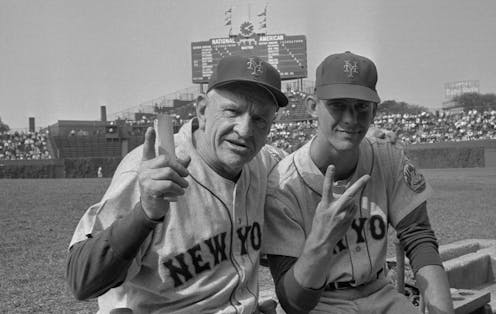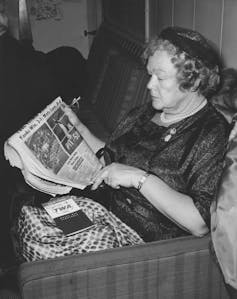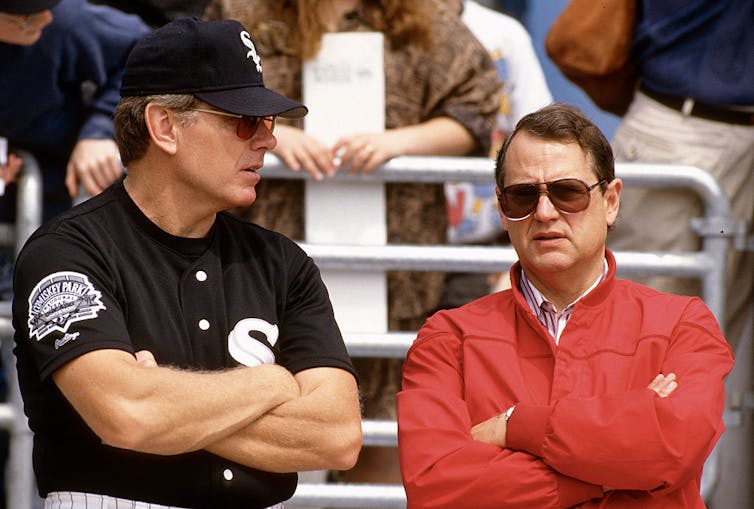What White Sox owner Jerry Reinsdorf can learn from the last team to lose 120 games
- Written by Nick Hirshon, Associate Professor of Communication, William Paterson University
 New York Mets manager Casey Stengel and outfielder Jim Hickman celebrate after breaking their 17-game losing streak in 1962.Bettmann/Getty Images
New York Mets manager Casey Stengel and outfielder Jim Hickman celebrate after breaking their 17-game losing streak in 1962.Bettmann/Getty ImagesBad press has engulfed Jerry Reinsdorf.
As owner of the Chicago White Sox, Reinsdorf heads a franchise with the most single-season losses in baseball history. The White Sox also set team records with a 21-game losing streak and losses in 20 straight series. In one game, a mundane pop fly went viral after two players collided, the ball rolled away, and three runs scored. In another, the team’s second baseman was injured by a ball to the face because he wasn’t paying attention to the catcher’s throw during warmups between innings.
Reporters have accused Reinsdorf of a “stunning” lack of accountability and “perverse revenge” against fans who want him to sell the team.
The negative media attention isn’t surprising. When a team fails so spectacularly, sports writers inevitably take swings at the owner, with one notable exception: the last team to lose 120 games, the 1962 New York Mets.
The Mets owner didn’t just manage to escape blame from the press.
She became the toast of the town.
‘Mother of the Mets’
Joan Whitney Payson had a decidedly elitist background. She grew up in one of the world’s wealthiest families, the benefactors of art museums and opera houses. She collected priceless paintings by the masters – Renoir, Monet, Cézanne, Matisse. Her grandfather had been secretary of state, and her brother was the U.S. ambassador to the U.K.
But Payson did share one trait with the American working class: a love of baseball. She grew up a rabid fan of the New York Giants and eventually came to own 10% of stock in the team. Like many New Yorkers, she was crushed in 1957 when the Giants relocated to California, a move she tried desperately to prevent. That same year, the Giants’ rival, the Brooklyn Dodgers, also headed west.
 Joan Whitney Payson reads the coverage of yet another Mets loss.FPG/Archive Photos via Getty Images
Joan Whitney Payson reads the coverage of yet another Mets loss.FPG/Archive Photos via Getty ImagesA city that had three thriving teams was down to just one: the Yankees, a longtime adversary that many Giants and Dodgers fans couldn’t bring themselves to root for.
Payson gave New Yorkers another option. Three years after the Giants and Dodgers left town, Payson bought an expansion club that was set to play in Queens. Anticipation for the new team energized the city. But in 1962, the first woman to purchase a sports team – a distinction that could have made her a target of the all-male press – led the Mets to a disastrous record: 40 wins against 120 losses.
In many ways, the 1962 Mets were worse than the 2024 White Sox. They made a whopping 210 errors; the White Sox will finish with half that many. Two Mets pitchers lost 20 games each; no one on the White Sox will come close. The White Sox outpaced the Mets in a range of categories, from doubles to stolen bases.
I research the history of sports media, and a few years ago, I set off to find out how the press covered Payson. I figured she must have been prime fodder for the tough New York media. When I was growing up, the Yankees and Mets never sank to the depths that Payson’s team did, yet the press still rebuked Yankees owner George Steinbrenner and the Mets’ Fred Wilpon, whose ownership group bought the team from the Payson family in 1980.
I spent many hours scanning newspapers on microfilm and digital databases. I made a trip to the Yale University archives to sift through Payson’s papers, and I combed her file at the National Baseball Hall of Fame and Museum, too.
I was certain reporters must have zeroed in on a few of the 1962 Mets’ many failings and pinned them on the owner.
But despite months of research, I didn’t find any negative coverage about the woman the press dubbed the “Mother of the Mets.”
A partner of the press
It’s much easier finding unfavorable stories about Reinsdorf. The owner of the White Sox since 1981, he is known for blowing off reporters. Even amid the national focus on the White Sox, he has not spoken to journalists for more than a year.
 Jerry Reinsdorf, right, has had a prickly relationship with the press since buying the Chicago White Sox in 1981.Focus on Sport/Getty Images
Jerry Reinsdorf, right, has had a prickly relationship with the press since buying the Chicago White Sox in 1981.Focus on Sport/Getty ImagesPayson, meanwhile, treated the press like partners.
The winter before her team’s inaugural season, she made an unprecedented gesture: inviting sports writers to her Manhattan duplex to help select the name of the team they would be covering. Payson wanted to go with Meadowlarks, a tribute to the team’s future home in Flushing Meadows. But the writers preferred Mets, an homage to a 19th-century New York team whose four-letter brevity worked well in headlines. In a decision that’s hard to imagine Reinsdorf making, Payson conceded to the press.
Later, during that 17-game skid, she took out newspaper ads thanking reporters in “the most tolerant city in the nation” for dispelling the notion “that New York is a cynical sports city, settling only for a winner.”
To be fair to the White Sox owner, Payson benefited from conditions that Reinsdorf cannot control.
Beat writers gave Payson grace after Major League Baseball forced her to draft the Mets roster from a pool of unwanted players from other clubs. Many of those journalists had lost work in 1957 when the Dodgers and Giants decamped for California. “These were very accomplished for their times guys who suddenly didn’t have teams to cover,” Robert Lipsyte, then a cub reporter at The New York Times, told me in an oral history interview in 2020. Payson gave these underworked sports writers a chance to cover the big leagues again.
In return, the Mets owner elicited effusive praise. In his book “Can’t Anybody Here Play This Game?” journalist Jimmy Breslin wrote that Payson “could be the best person to come into baseball in our time.”
No one at the Chicago Tribune or Sun-Times makes the same lofty claim for Reinsdorf.
Knives out?
After her team’s 120-loss campaign, Payson entered the offseason as a media darling. The press appreciated her good nature and accessibility for interviews even as the Mets floundered.
In comparison, Reinsdorf’s combination of on-field futility and off-field coolness to the Chicago media has assured him a spot in the annals of infamy.
With two and a half weeks to go in the season, Reinsdorf put out a statement acknowledging “this year has been very painful for all” and promising that he will “have more to say at the end of the season.”
At this point, what Reinsdorf says probably won’t matter much. Rather than learning from Payson’s approach, he has made it easy for the press to cast him as a villain.
Nick Hirshon does not work for, consult, own shares in or receive funding from any company or organization that would benefit from this article, and has disclosed no relevant affiliations beyond their academic appointment.
Authors: Nick Hirshon, Associate Professor of Communication, William Paterson University
